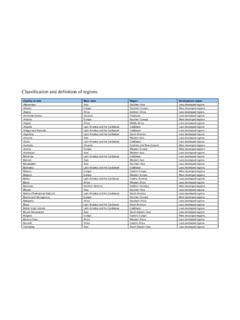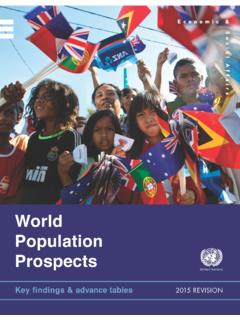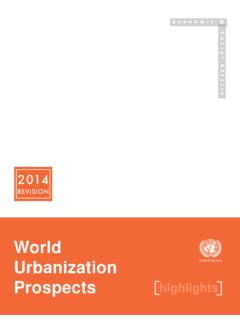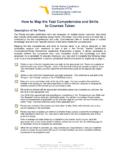Transcription of MACROECONOMIC AND GROWTH POLICIES
1 NATIONAL development STRATEGIES. POLICY notes . UN DESA. MACROECONOMIC . AND. GROWTH POLICIES . Shari Spiegel Executive Director Initiative for Policy Dialogue (IPD). Columbia University, New York UNITED NATIONS. DEPARTMENT FOR ECONOMIC AND SOCIAL AFFAIRS (UNDESA). -2007- Acknowledgements Much of this note is based on Joseph E. Stiglitz, Jose Antonio Ocampo, Shari Spiegel, Ricardo Ffrench Davis, and Deepak Nayyar, Stability with GROWTH , Oxford University Press, 2006. For a more detailed analysis of many of the issues covered in this note please refer to Stability with GROWTH . The section on aid delivery and absorption is taken from Benu Schneider, Aid Delivery, Management and Absorption', UN DESA, Mimeo, 2006. Thanks also to Jomo K. Sundaram, Assistant Secretary General for Economic development , UN; Jose Antonio Ocampo, Secretary General for Economic development , UN; Isabel Ortiz and Alejandro Izurieta, UN DESA; Rudi von Arnim, and Sid Gupta and Ray Koytcheff at the Initiative for Policy Dialogue at Columbia University.
2 DESA gratefully acknowledges the financial support of UNDP for the project to produce this note New York, June 2007. Copyright United Nations DESA. This Policy Note aims to foster consideration and discussion of policy options in the preparation of National development Strategies. The analyses, assessments and data have been prepared by the authors and revised in response to feedback from various reviewers. They do not necessarily represent the views of UN DESA , and appropriate credit should be given to the author for citation purposes. 2. Preface The outcome document of the 2005 United Nations World Summit called on countries to prepare national development strategies, taking into account the international development goals agreed in the various United Nations Summits and Conferences of the past two decades. In order to assist countries in this task, the United Nations Department of Economic and Social Affairs (DESA) commissioned a series of notes for policy-makers and policy-shapers both in the government and civil society, in major and interconnected areas relevant to the formulation of national development strategies: MACROECONOMIC and GROWTH POLICIES , trade policy, investment and technology POLICIES , financial POLICIES , social policy and state-owned enterprise reform.
3 The preparation of the notes received generous funding in part from the United Nations development Programme (UNDP). Colleagues from UNDP also provided helpful suggestions for and comments on the notes . The policy notes , authored by experts in these fields, draw on the experience and dialogues of the United Nations in the economic and social areas, complemented by outside knowledge. The notes provide concrete suggestions on the means to achieve at the national level, the internationally-agreed development goals synthesized in the United Nations development Agenda. The policy notes are intended to provide those at the country level who shape and set POLICIES , with a range of possible alternatives to the standard policy solutions that have prevailed over the past two decades, rather than to prescribe any single course of action. The notes serve to help countries take advantage of and expand their policy space - their effective room for maneuver in formulating and integrating national economic, social, and environmental POLICIES .
4 I encourage readers to see these notes as complementary inputs into the debate at the country level on development challenges faced and the POLICIES needed to meet them. The issues chosen are vital pieces of the policy mosaic that underlies national development strategies, which are ultimately geared to achieving sustained economic GROWTH with social inclusion and environmental protection. Jos Antonio Ocampo Under-Secretary-General for Economic and Social Affairs United Nations New York, June 2007. 3. Table of Contents Page I. Introduction .. 6. II. MACROECONOMIC Objectives .. 6. Stabilization and GROWTH .. 7. Inflation 7. The Impact of Inflation on GROWTH 9. The Costs of Fighting Inflation . 11. External balance .. 12. Unemployment and poverty . 13. III. Fiscal, Monetary and Exchange Rate POLICIES .. 15. Fiscal Policy . 15. Sources of Fiscal Revenue and Policy 15. Borrowing Constraints . 15. Aid Delivery and Absorption 16. Public Resource Mobilization .. 17.
5 The Effectiveness of Fiscal Policy .. 21. The Pro-cyclical Bias of Fiscal Policy .. 23. Alternative Fiscal Policy Measures .. 24. Fiscal Policy Accounting: Structural and Primary Deficits 24. Management of Public-Private Partnerships .. 25. Automatic Stabilizers: Fiscal Stabilization Funds 25. Counter-cyclical Tax POLICIES and Other Fiscal Policy Alternatives 26. Monetary Policy 29. The Effectiveness of Monetary Policy . 29. Monetary Policy Instruments .. 31. Indirect Monetary Policy Instrument 32. Direct Mechanisms and Other Microeconomic Measures 33. The MACROECONOMIC Dimensions of Prudential Regulation 34. Exchange Rate Policy 36. Impact of Devaluation . 37. The Impact on Aggregate Demand and GROWTH 37. Impact on Inflation 38. Real Balance Sheet Effects 39. The Debate on Exchange Rate Regime 40. Fixed and Floating Rate Regimes . 40. Interventions in Foreign Exchange Markets . 41. Intermediate Regimes 43. Microeconomic Measures 44. 4. Policy Rules and Institutional Design 46.
6 Rules vs. Discretion and Inflation Targeting vs. Foreign Exchange Targeting .. 46. Central Bank Mandate 48. An Independent Central Bank 49. IV. Capital Market Interventions and Other Policy Options for Open Economies . 49. Interventions in Capital Markets . 49. Price and Quantity Based Controls on Inflows and Outflows 50. Soft Controls: Encouraging Market Segmentation . 53. Indirect interventions through prudential regulations 53. Public-Sector Liability Management in Developing Countries .. 56. Conclusion: Microeconomic Interventions and Other Heterodox Measures .. 58. V. References . 59. Boxes Box 1 The Impact of Inflation on Inequality . 11. Box 2 Taxation of Multinational Corporations . 20. Box 3 Managing the Dutch Disease .. 45. Box 4 Accounting Frameworks . 54. 5. macroeconomics AND G ROWTH POLICY NOTE*. I. INTRODUCTION. Since the 1990s, many developing countries have had remarkable success in reducing inflation, as well as improving fiscal and current account deficits.
7 Yet, countries have not been as successful at achieving stability of MACROECONOMIC output and sustainable GROWTH . This is in large part because stabilization POLICIES have focused on price stability even though real stability, not price stability, is what's ultimately important for attracting investment and achieving sustainable development . This policy note lays out a framework for designing MACROECONOMIC policy geared toward real MACROECONOMIC stability with GROWTH . This framework is based on the view that there need to be broader goals, additional instruments beyond fiscal and monetary POLICIES (including capital account management, regulations, and other microeconomic tools), and a balanced role for government and the private sector. In addition, policymakers need to coordinate fiscal, monetary, exchange rate POLICIES and design programs based on flexibility and the individual needs of each country. This note is divided into three sections. The first discusses MACROECONOMIC objectives, and the need for a broader set of policy goa ls.
8 The second examines the conventional tools of MACROECONOMIC policymaking: fiscal, monetary, and exchange rate POLICIES . The third and final section of this note looks at alternative tools for MACROECONOMIC management, with an emphasis on interventions in capital markets. Some of the issues discussed, such as public sector revenue mobilization, are relevant to current policy choices in both low income and middle income countries. Some sections, such as aid modalities, aid and the Dutch disease', and to some extent, direct mechanisms of monetary policy, are geared toward low income countries. Many issues, such as some of the discussion on prudential regulatory structures and accounting for structural deficits, are more appropriate for middle income countries with greater administrative capacity. But we hope the discussion will give all policymakers ideas of creative measures that can be used to overcome market failures. II. MACROECONOMIC OBJECTIVES. We begin our discussion by focusing on the objectives of macro-economic policymaking.
9 At the most general level, the goal of economic policy is to maximize long-run societal well-being in an equitable and sustainable manner. Much of the recent discussion of economic policy has focused on intermediate variables, such as price stability or the balance of payments. Intermediate variables, however, are not important in their own right. Their importance derives largely from their role as possible indicators of economic performance in terms of truly significant varia bles, such as GROWTH , development and equity. For example, price stability should be seen as a tool for achieving important long-run objectives, such as greater efficiency and long-term GROWTH . The centre of attention of MACROECONOMIC policymaking should be *. This Policy Note has been prepared by Shari Spiegel, Director, Initiative for Policy Dialogue, Columbia University Business School, New York. All comments and queries can be sent to 6. on real macroeconomics ' and the use of productive capacity the employment of capital and labour at their highest potential level and improvements in that productivity.
10 Stabilization and GROWTH What people truly care about is the stability and GROWTH of their real incomes. It should be obvious why GROWTH is important: even small changes in the rate of GROWTH , say, from per cent to 3 per cent, add up significantly over time because of the effect of compounding. With a GROWTH rate of per cent, incomes double every 28. years; with a GROWTH rate of 3 per cent, they double every 23 years. It's the overall stability of output and the real economy, and not just price stability, that concerns firms when they make investment decisions. High instability generates an unfriendly' domestic macro-environment that appears to be a crucial factor in explaining low rates of capital formation: firms have less incentive to invest, and GROWTH will be lower. Similarly, economic POLICIES that lead to fuller utilization of resources today may also lead to higher incomes in the future. This implies that there may be less of a trade -off between GROWTH and stability than orthodox economics suggests.















